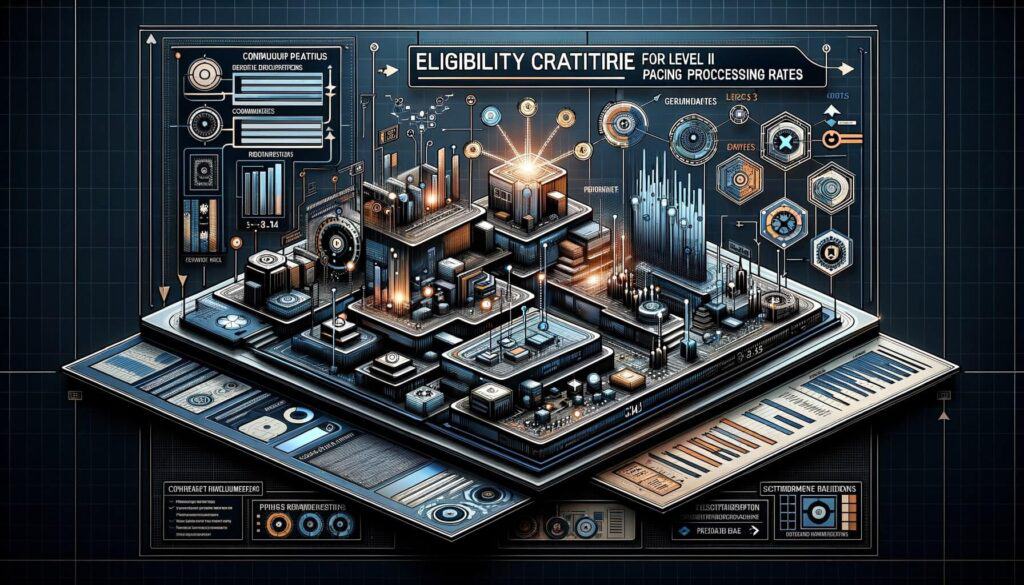
By Mollie Mills February 27, 2025
In the ever-evolving world of payment processing, businesses are constantly seeking ways to optimize their operations and reduce costs. One such avenue is qualifying for Level III processing rates, which can provide significant savings for businesses that process a high volume of business-to-business (B2B) transactions.
In this comprehensive guide, we will delve into the intricacies of Level III processing rates, exploring what they are, the benefits they offer, the eligibility criteria, and the steps businesses can take to qualify for these rates in 2025.
What are Level III Processing Rates?
Level III processing rates refer to a specific pricing structure offered by payment processors for B2B transactions. Unlike traditional processing rates, which are typically higher for B2B transactions due to the increased risk associated with these types of payments, Level III processing rates are significantly lower. This is because Level III processing requires the inclusion of detailed transaction data, providing additional information to the card issuer and reducing the risk of fraud.
Benefits of Qualifying for Level III Processing Rates

Qualifying for Level III processing rates can offer numerous benefits for businesses, particularly those that process a high volume of B2B transactions. Some of the key advantages include:
1. Cost Savings: Level III processing rates are significantly lower than traditional rates for B2B transactions. By qualifying for these rates, businesses can reduce their payment processing costs, resulting in substantial savings over time.
2. Competitive Advantage: Offering lower processing rates for B2B transactions can give businesses a competitive edge in the market. This can attract more B2B customers who are looking for cost-effective payment solutions, ultimately driving business growth.
3. Enhanced Cash Flow: Lower processing rates mean businesses can retain a larger portion of their revenue from B2B transactions. This improved cash flow can be reinvested into the business, allowing for expansion, innovation, and increased profitability.
4. Improved Relationships with Suppliers: B2B transactions often involve working closely with suppliers. By offering lower processing rates, businesses can strengthen their relationships with suppliers, fostering loyalty and potentially negotiating better terms and discounts.
Eligibility Criteria for Level III Processing Rates

While the benefits of Level III processing rates are enticing, not all businesses are eligible to qualify for these rates. Payment processors have specific criteria that businesses must meet to be considered for Level III processing rates. Some common eligibility criteria include:
1. Business Type: Level III processing rates are typically available for businesses that primarily engage in B2B transactions. This includes wholesalers, manufacturers, distributors, and other businesses that frequently transact with other businesses.
2. Transaction Volume: Businesses must have a high volume of B2B transactions to be eligible for Level III processing rates. Payment processors often have minimum transaction thresholds that businesses must meet to qualify.
3. Card Acceptance: Businesses must accept commercial or purchasing cards to be eligible for Level III processing rates. These types of cards are commonly used in B2B transactions and require the inclusion of detailed transaction data.
4. Data Requirements: Level III processing rates require the inclusion of specific transaction data, as outlined by the payment processor. Businesses must be able to provide this data for each B2B transaction to qualify for the lower rates.
Steps to Qualify for Level III Processing Rates

Now that we understand what Level III processing rates are and the eligibility criteria, let’s explore the steps businesses can take to qualify for these rates in 2025. While the specific requirements may vary depending on the payment processor, the following steps provide a general roadmap for businesses to follow:
1. Research Payment Processors: Start by researching payment processors that offer Level III processing rates. Look for reputable providers with a track record of supporting B2B transactions and offering competitive rates.
2. Assess Transaction Volume: Evaluate your business’s transaction volume to determine if it meets the minimum threshold required by payment processors. If your volume falls short, consider strategies to increase B2B transactions, such as targeting new markets or expanding product offerings.
3. Review Card Acceptance: Ensure your business accepts commercial or purchasing cards. If you currently do not accept these types of cards, contact your payment processor to explore options for adding them to your payment acceptance methods.
4. Understand Data Requirements: Familiarize yourself with the specific data requirements for Level III processing rates. This may include line-item details, such as product descriptions, quantities, unit prices, and tax information. Ensure your systems and processes can capture and transmit this data accurately.
5. Update Payment Systems: If your current payment systems do not support the collection and transmission of Level III data, consider upgrading or integrating new systems. Consult with your payment processor or a technology provider to identify the best solution for your business.
6. Train Staff: Educate your staff on the importance of collecting and inputting accurate Level III data. Provide training on how to capture the required information and ensure it is consistently included in B2B transactions.
7. Test and Validate Data: Conduct thorough testing to ensure the accuracy and completeness of Level III data. This may involve running test transactions and verifying that all required data fields are populated correctly.
8. Communicate with Suppliers: Reach out to your suppliers and inform them of your intention to qualify for Level III processing rates. Discuss the benefits they may also gain from this qualification and ensure they are willing and able to provide the necessary data on their end.
9. Monitor and Optimize: Once you have qualified for Level III processing rates, continue to monitor and optimize your data collection and transmission processes. Regularly review transaction data to identify any discrepancies or areas for improvement.
10. Stay Informed: Keep abreast of any updates or changes in Level III processing requirements. Payment processors may periodically revise their criteria, and it is essential to stay informed to maintain your qualification for these rates.
Understanding Level III Data Requirements

To qualify for Level III processing rates, businesses must provide specific transaction data that goes beyond the basic information typically included in payment transactions. This additional data provides card issuers with a more detailed view of the transaction, reducing the risk of fraud and enabling more accurate reporting. The exact data requirements may vary depending on the payment processor, but some common elements include:
1. Line-Item Details: Level III processing requires the inclusion of line-item details for each product or service purchased in a B2B transaction. This includes information such as product descriptions, quantities, unit prices, and extended amounts.
2. Tax Information: Businesses must provide tax-related data, including tax amounts and tax rates, for each line item. This ensures compliance with tax regulations and facilitates accurate reporting for both the buyer and seller.
3. Customer Information: Level III processing often requires the inclusion of customer-specific data, such as the customer’s name, address, and tax identification number. This information helps verify the legitimacy of the transaction and supports reporting requirements.
4. Merchant Information: Businesses may need to provide their own merchant-specific data, such as their name, address, and tax identification number. This information helps card issuers and processors identify the merchant responsible for the transaction.
5. Order Information: Level III processing may require the inclusion of order-related data, such as purchase order numbers or invoice numbers. This helps link the transaction to specific orders and facilitates reconciliation and tracking.
Tips to Optimize Level III Data for Qualification
Collecting and transmitting accurate Level III data is crucial for qualifying for Level III processing rates. To optimize your data for qualification, consider the following tips:
1. Implement Robust Systems: Invest in payment systems that can capture and transmit Level III data accurately. Look for solutions that integrate seamlessly with your existing processes and provide comprehensive reporting capabilities.
2. Standardize Data Collection: Establish standardized processes for collecting Level III data. Train your staff to consistently gather the required information for each B2B transaction, ensuring accuracy and completeness.
3. Automate Data Entry: Leverage automation tools to streamline data entry processes. This reduces the risk of human error and speeds up the collection and transmission of Level III data.
4. Validate Data Accuracy: Regularly validate the accuracy of Level III data by cross-referencing it with supporting documentation, such as invoices or purchase orders. Implement checks and balances to catch any discrepancies before they impact your qualification for Level III processing rates.
5. Regularly Update Systems: Stay up to date with the latest software updates and patches for your payment systems. This ensures that any changes or enhancements related to Level III data requirements are implemented promptly.
6. Communicate with Suppliers: Maintain open lines of communication with your suppliers to ensure they understand the importance of providing accurate Level III data. Collaborate on data collection processes and address any issues or challenges that may arise.
7. Conduct Internal Audits: Periodically conduct internal audits to assess the accuracy and completeness of Level III data. This helps identify any areas for improvement and ensures ongoing compliance with processing requirements.
8. Seek Expert Guidance: If you are unsure about how to optimize your Level III data, consider seeking guidance from payment processing experts or consultants. They can provide valuable insights and recommendations based on their industry knowledge and experience.
Common Challenges and Solutions in Qualifying for Level III Processing Rates
While qualifying for Level III processing rates can be highly beneficial, businesses may encounter challenges along the way. Understanding these challenges and implementing appropriate solutions can help overcome obstacles and increase the likelihood of qualification. Some common challenges and their corresponding solutions include:
1. Limited Transaction Volume: If your business does not currently meet the minimum transaction volume required for Level III processing rates, consider strategies to increase B2B transactions. This may involve targeting new markets, expanding product offerings, or implementing marketing campaigns to attract more B2B customers.
2. Incompatible Payment Systems: If your current payment systems do not support Level III data requirements, explore options for upgrading or integrating new systems. Consult with your payment processor or a technology provider to identify the best solution for your business.
3. Data Collection and Entry Errors: Human errors in data collection and entry can jeopardize your qualification for Level III processing rates. Implement standardized processes, provide training to staff, and leverage automation tools to minimize errors and ensure data accuracy.
4. Supplier Cooperation: If your suppliers are unwilling or unable to provide the necessary Level III data, communicate the benefits they may also gain from qualifying for these rates. Emphasize the potential cost savings and improved relationships that can result from Level III processing.
5. Lack of Awareness: Some businesses may be unaware of Level III processing rates and the potential benefits they offer. Educate yourself and your team about these rates, and proactively reach out to payment processors to explore qualification opportunities.
Frequently Asked Questions (FAQs) about Level III Processing Rates
Q1. What is the difference between Level II and Level III processing rates?
Answer: Level II processing rates require the inclusion of basic transaction data, such as the merchant name, transaction amount, and tax amount. Level III processing rates, on the other hand, require more detailed line-item data, including product descriptions, quantities, unit prices, and tax information.
Q2. Can any business qualify for Level III processing rates?
Answer: No, not all businesses are eligible for Level III processing rates. Typically, these rates are available for businesses that primarily engage in B2B transactions, have a high transaction volume, accept commercial or purchasing cards, and can provide the required Level III data.
Q3. How much can businesses save by qualifying for Level III processing rates?
Answer: The exact savings will vary depending on the business’s transaction volume and the specific Level III processing rates offered by the payment processor. However, businesses can typically expect significant cost savings compared to traditional processing rates for B2B transactions.
Q4. Do Level III processing rates apply to international transactions?
Answer: Yes, Level III processing rates can apply to both domestic and international B2B transactions. However, businesses should consult with their payment processor to understand any specific requirements or considerations for international transactions.
Q5. Can businesses qualify for Level III processing rates retroactively?
Answer: In most cases, businesses cannot qualify for Level III processing rates retroactively. Qualification typically applies to future transactions once the necessary data requirements are met. However, it is essential to consult with your payment processor to understand their specific policies and procedures.
Conclusion
Qualifying for Level III processing rates in 2025 can provide significant cost savings and competitive advantages for businesses that process a high volume of B2B transactions. By understanding what Level III processing rates are, the benefits they offer, the eligibility criteria, and the steps to qualify, businesses can optimize their payment processing operations and reduce costs.
Implementing robust systems, collecting accurate Level III data, and addressing common challenges can increase the likelihood of qualification and pave the way for long-term success in the evolving landscape of payment processing.